Evaluating Forest Cover and Fragmentation in Costa Rica with a Corrected Global Tree Cover Map
Abstract
1. Introduction
2. Materials and Methods
2.1. Reference Tree Cover and Bias Estimation
2.2. Modeling Bias along Biophysical Gradients
2.3. Agricultural Cover Classification
2.4. Revising GFC Forest Cover
2.5. Forest Fragmentation Analysis Comparison
3. Results
3.1. Elevation and Precipitation Bias Assessment and Correction
3.2. Agricultural Cover Bias Assessment and Correction
3.3. Corrected Forest Cover Comparison
4. Discussion
5. Conclusions
Author Contributions
Funding
Acknowledgments
Conflicts of Interest
Appendix A
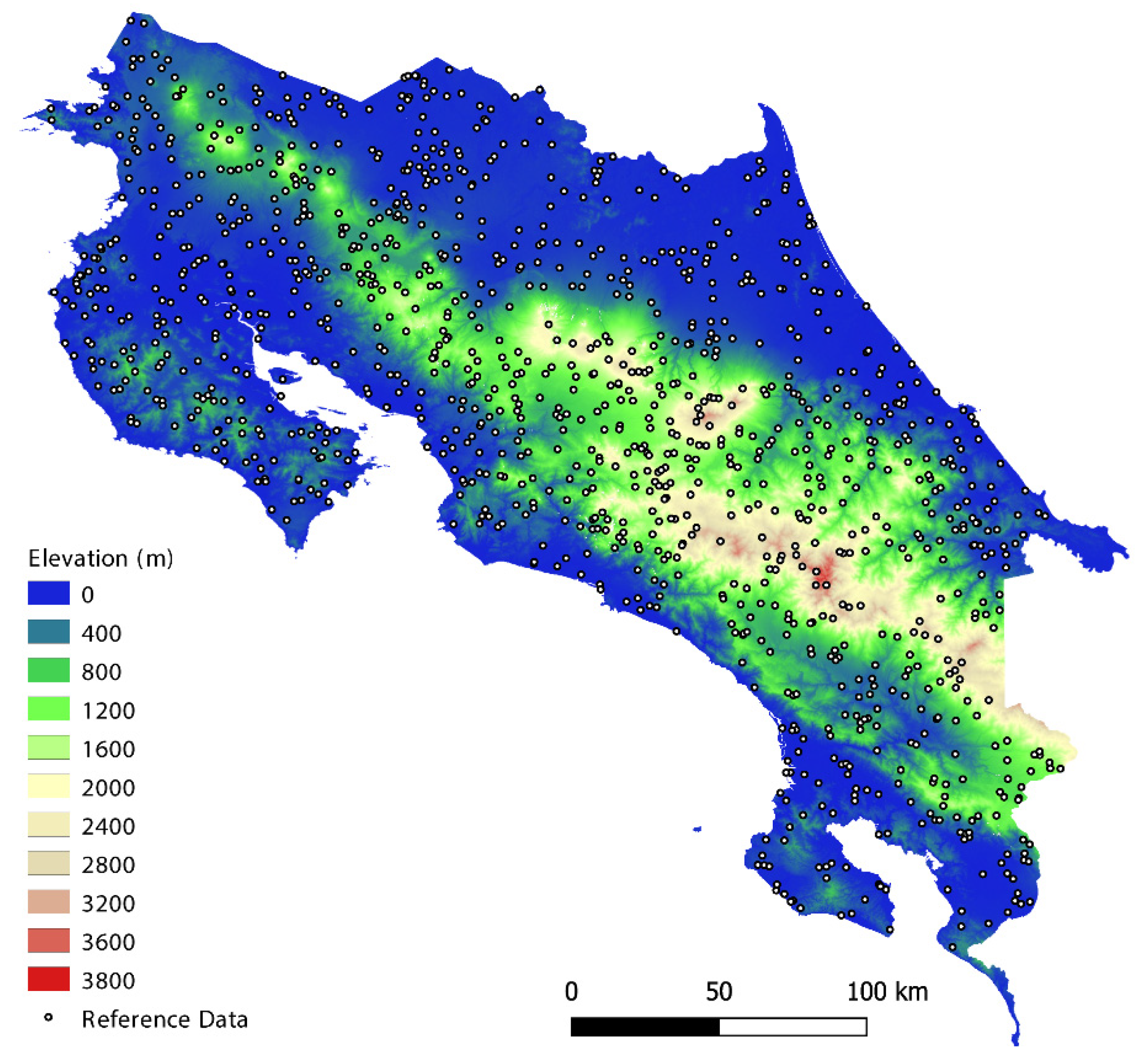







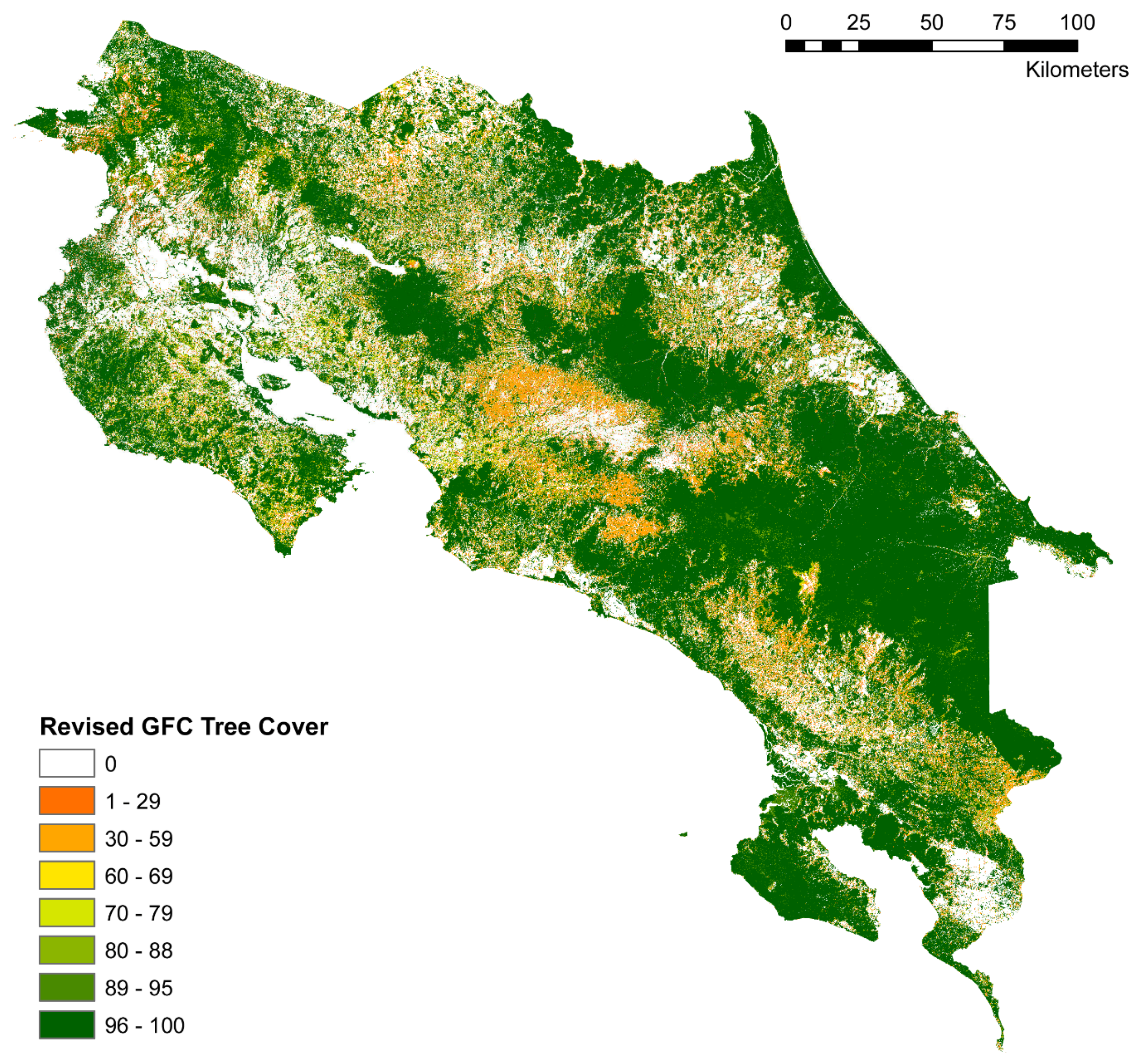
| Top Costa Rican Crops by Area Harvested, 2015 | ||
|---|---|---|
| Crop | Area Harvested (km2) | FAOstat Description |
| Coffee, green | 841.33 | Official data |
| Oil palm fruit | 694.26 | Official data |
| Sugarcane | 646.76 | Official data |
| Fruit, fresh * | 510.62 | FAO data based on imputation methodology |
| Rice, paddy | 489.01 | Official data |
| Banana | 430.24 | Official data |
| Pineapple | 400.00 | Official data |
| Strata(i) | Mapped Proportion (Wi) | Conjectured Values of Accuracy (Ui) | Standard Deviation of Strata (Si) | Final Allocation |
|---|---|---|---|---|
| Background | 0.922 | 0.85 | 0.357 | 675 |
| Rice | 0.027 | 0.85 | 0.357 | 100 |
| Sugarcane | 0.003 | 0.85 | 0.357 | 100 |
| Pineapple | 0.009 | 0.85 | 0.357 | 100 |
| Banana | 0.010 | 0.85 | 0.357 | 100 |
| Palm | 0.009 | 0.85 | 0.357 | 100 |
| Coffee | 0.019 | 0.85 | 0.357 | 100 |
| Total Units (n) | 1275 |
| Agricultural Land Cover Map Accuracy | |||||||||
|---|---|---|---|---|---|---|---|---|---|
| Reference | |||||||||
| Classified | Bg | Ri | Sc | Pa | Ba | Op | Co | Total | Users |
| Background (Bg) | 664 | 0 | 3 | 1 | 3 | 3 | 674 | 99% | |
| Rice (Ri) | 32 | 67 | 1 | 100 | 67% | ||||
| Sugarcane (Sc) | 28 | 72 | 100 | 72% | |||||
| Pineapple (Pa) | 8 | 1 | 1 | 91 | 100 | 91% | |||
| Banana (Ba) | 7 | 1 | 92 | 100 | 92% | ||||
| Oil palm (Op) | 11 | 1 | 88 | 100 | 88% | ||||
| Coffee (Co) | 19 | 81 | 100 | 81% | |||||
| Total | 769 | 68 | 77 | 91 | 94 | 92 | 84 | 1274 | |
| Producers | 86% | 99% | 94% | 100% | 98% | 96% | 96% | ||
| Overall Accuracy | 89.2% | ||||||||
| Reference Data Thresholded at 89% | |||||
|---|---|---|---|---|---|
| GFC, Original (2015) | Reference Data | ||||
| Predicted | Nonforest | Forest | Total | User Acc. | Original Map Area (km2) |
| Nonforest | 0.3623 (259) | 0.1245 (89) | 0.487 | 74.4 | 29,571 |
| Forest | 0.0788 (59) | 0.4343 (325) | 0.513 | 84.6 | 31,167 |
| Total | 0.4412 | 0.5588 | 1 | Overall | Corrected Area (km2) |
| Prod. Acc. | 82.1 | 77.7 | 79.7 ±2.9 | NF: 26,797 ± 1763 For: 33,941 ± 1763 | |
| Precip/Elev Corr. | Reference Data | ||||
| Predicted | Nonforest | Forest | Total | User Acc. | Original Map Area (km2) |
| Nonforest | 0.3365 (244) | 0.0703 (51) | 0.407 | 82.7 | 24,709 |
| Forest | 0.1004 (74) | 0.4927 (363) | 0.593 | 83.1 | 36,030 |
| Total | 0.4369 | 0.5631 | 1 | Overall | Corrected Area (km2) |
| Prod. Acc. | 77.0 | 87.5 | 82.9 ±2.7 | NF: 26,538 ± 1658 For: 34,200 ± 1658 | |
| Ag Corr. Only | Reference Data | ||||
| Predicted | Nonforest | Forest | Total | User Acc. | Original Map Area (km2) |
| Nonforest | 0.3823 (274) | 0.1242 (89) | 0.506 | 75.5 | 30,763 |
| Forest | 0.0588 (44) | 0.4347 (325) | 0.494 | 88.1 | 29,975 |
| Total | 0.4412 | 0.5588 | 1 | Overall | Corrected Area (km2) |
| Prod. Acc. | 86.7 | 77.8 | 81.7 ±2.8 | NF: 26,795 ± 1686 For: 33,943 ± 1686 | |
| Revised GFC | Reference Data | ||||
| Predicted | Nonforest | Forest | Total | User Acc. | Original Map Area (km2) |
| Nonforest | 0.3563 (259) | 0.0702 (51) | 0.426 | 83.5 | 25,901 |
| Forest | 0.0802 (59) | 0.4934 (363) | 0.574 | 86.0 | 34,838 |
| Total | 0.4365 | 0.5635 | 1 | Overall | Corrected Area (km2) |
| Prod. Acc. | 81.6 | 87.6 | 85.0 ±2.6 | NF: 26,510 ± 1574 For: 34,228 ± 1574 | |
References
- Lewis, S.L.; Edwards, D.P.; Galbraith, D. Increasing human dominanceof tropical forests. Science (80-) 2015, 349, 827–832. [Google Scholar] [CrossRef] [PubMed]
- Gibson, L.; Ming Lee, T.; Koh, L.P.; Brook, B.W.; Gardner, T.A.; Barlow, J.; Peres, C.A.; Bradshaw, C.J.A.; Laurance, W.F.; Lovejoy, T.E.; et al. Primary forests are irreplaceable for sustainingtropical biodiversity. Nature 2011, 478, 378–381. [Google Scholar] [CrossRef] [PubMed]
- Venter, O.; Laurance, W.F.; Iwamura, T.; Wilson, K.A.; Fuller, R.A.; Possingham, H.P. Harnessing Carbon Payments to Protect Biodiversity. Science 2009, 326, 1368. [Google Scholar] [CrossRef] [PubMed]
- Kindermann, G.; Obersteiner, M.; Sohngen, B.; Sathaye, J.; Andrasko, K.; Rametsteiner, E.; Schlamadinger, B.; Wunder, S.; Beach, R. Global cost estimates of reducing carbon emissions through avoided deforestation. Proc. Natl. Acad. Sci. USA 2008, 105, 10302–10307. [Google Scholar] [CrossRef] [PubMed]
- Vijay, V.; Pimm, S.L.; Jenkins, C.N.; Smith, S.J. The Impacts of Oil Palm on Recent Deforestation and Biodiversity Loss. PLoS ONE 2016, 11, e0159668. [Google Scholar] [CrossRef]
- Gibbs, H.K.; Ruesch, A.S.; Achard, F.; Clayton, M.K.; Holmgren, P.; Ramankutty, N.; Foley, J.A. Tropical forests were the primary sources of new agricultural land in the 1980s and 1990s. Proc. Natl. Acad. Sci. USA 2010, 107, 16732–16737. [Google Scholar] [CrossRef] [PubMed]
- Grainger, A. Uncertainty in the construction of global knowledge of tropical forests. Prog. Phys. Geogr. 2010, 34, 811–844. [Google Scholar] [CrossRef]
- Kaiser, J. Satellites Spy More Forest Than Expected. Science 2002, 297, 9–10. [Google Scholar] [CrossRef]
- Kleinn, C.; Corrales, L.; Morales, D. Forest area in costa rica: A comparative study of tropical forest cover estimates over time. Environ. Monit. Assess. 2002, 73, 17–40. [Google Scholar] [CrossRef]
- Grainger, A. Difficulties in tracking the long-term global trend in tropical forest area. Proc. Natl. Acad. Sci. USA 2008, 105, 818–823. [Google Scholar] [CrossRef] [PubMed]
- Grinand, C.; Rakotomalala, F.; Gond, V.; Vaudry, R.; Bernoux, M.; Vieilledent, G. Estimating deforestation in tropical humid and dry forests in Madagascar from 2000 to 2010 using multi-date Landsat satellite images and the random forests classifier. Remote Sens. Environ. 2013, 139, 68–80. [Google Scholar] [CrossRef]
- Achard, F.; Beuchle, R.; Mayaux, P.; Stibig, H.; Bodart, C.; Brink, A.; Carboni, S.; Desclee, B.; Donnay, F.; Eva, H.D.; et al. Determination of tropical deforestation rates and related carbon losses from 1990 to 2010. Glob. Chang. Biol. 2014, 20, 2540–2554. [Google Scholar] [CrossRef] [PubMed]
- Chazdon, R.L.; Brancalion, P.H.S.; Laestadius, L.; Bennett-Curry, A.; Buckingham, K.; Kumar, C.; Moll-Rocek, J.; Vieira, I.C.G.; Wilson, S.J. When is a forest a forest? Forest concepts and definitions in the era of forest and landscape restoration. Ambio 2016, 45, 538–550. [Google Scholar] [CrossRef] [PubMed]
- Sexton, J.O.; Noojipady, P.; Song, X.-P.P.; Feng, M.; Song, D.-X.X.; Kim, D.-H.H.; Anand, A.; Huang, C.; Channan, S.; Pimm, S.L.L.; et al. Conservation policy and the measurement of forests. Nat. Clim. Chang. 2016, 6, 192–196. [Google Scholar] [CrossRef]
- Cunningham, D.; Cunningham, P.; Fagan, M.E.M.E. Identifying biases in global tree cover products: A case study in Costa Rica. Forests 2019, 10, 853. [Google Scholar] [CrossRef]
- Young, N.E.; Anderson, R.S.; Chignell, S.M.; Vorster, A.G.; Lawrence, R.; Evangelista, P.H. A survival guide to Landsat preprocessing. Ecology 2017, 98, 920–932. [Google Scholar] [CrossRef]
- Wilson, A.M.; Jetz, W. Remotely Sensed High-Resolution Global Cloud Dynamics for Predicting Ecosystem and Biodiversity Distributions. PLoS Biol. 2016, 14, e1002415. [Google Scholar] [CrossRef] [PubMed]
- Asner, G.P. Cloud cover in Landsat observations of the Brazilian Amazon. Int. J. Remote Sens. 2001, 22, 3855–3862. [Google Scholar] [CrossRef]
- Bastin, J.F.; Berrahmouni, N.; Grainger, A.; Maniatis, D.; Mollicone, D.; Moore, R.; Patriarca, C.; Picard, N.; Sparrow, B.; Abraham, E.M.; et al. The extent of forest in dryland biomes. Science 2017, 356, 635–638. [Google Scholar] [CrossRef] [PubMed]
- Kalacska, M.; Sanchez-Azofeifa, G.A.; Rivard, B.; Caelli, T.; White, H.P.; Calvo-Alvarado, J.C. Ecological fingerprinting of ecosystem succession: Estimating secondary tropical dry forest structure and diversity using imaging spectroscopy. Remote Sens. Environ. 2007, 108, 82–96. [Google Scholar] [CrossRef]
- Tropek, R.; Beck, J.; Keil, P.; Musilová, Z.; Irena, Š.; Storch, D.; Sedláček, O.; Beck, J.; Keil, P.; Musilová, Z.; et al. Comment on “High-resolution global maps of 21st-century forest cover change”. Science 2014, 344, 981. [Google Scholar] [CrossRef] [PubMed]
- Laurance, W.F.; Sayer, J.; Cassman, K.G. Agricultural expansion and its impacts on tropical nature. Trends Ecol. Evol. 2013, 29, 107–116. [Google Scholar] [CrossRef] [PubMed]
- Fitzherbert, E.B.; Struebig, M.J.; Morel, A.; Danielsen, F.; Brühl, C.A.; Donald, P.F.; Phalan, B. How will oil palm expansion affect biodiversity? Trends Ecol. Evol. 2008, 23, 538–545. [Google Scholar] [CrossRef] [PubMed]
- Li, Y.; Sulla-Menashe, D.; Motesharrei, S.; Song, X.; Ying, Q.; Li, S.; Ma, Z. Inconsistent estimates of forest cover change in China between 2000 and 2013 from multiple datasets: Differences in parameters, spatial resolution, and definitions. Sci. Rep. 2017, 7, 1–12. [Google Scholar] [CrossRef] [PubMed]
- Potapov, P.V.; Turubanova, S.A.; Tyukavina, A.; Krylov, A.M.; Mccarty, J.L.; Radeloff, V.C.; Hansen, M.C. Remote Sensing of Environment Eastern Europe’s forest cover dynamics from 1985 to 2012 quanti fi ed from the full Landsat archive. Remote Sens. Environ. 2015, 159, 28–43. [Google Scholar] [CrossRef]
- Sannier, C.; McRoberts, R.E.; Fichet, L.-V.V. Suitability of Global Forest Change data to report forest cover estimates at national level in Gabon. Remote Sens. Environ. 2016, 173, 326–338. [Google Scholar] [CrossRef]
- Guindon, L.; Pernier, I.B.; Sylvie, G.; Graham, S.; Villemaire, P.; Beaudon, A. Missing forest cover gains in boreal forests explained. Ecosphere 2018, 9, e02094. [Google Scholar] [CrossRef]
- Hansen, M.C.; Potapov, P.V.; Moore, R.; Hancher, M.; Turubanova, S.A.; Tyukavina, A.; Thau, D.; Stehman, S.V.; Goetz, S.J.; Loveland, T.R.; et al. High-resolution global maps of 21st-century forest cover change. Science 2013, 342, 850–853. [Google Scholar] [CrossRef] [PubMed]
- Richards, D.R.; Friess, D.A. Rates and drivers of mangrove deforestation in Southeast Asia, 2000–2012. Proc. Natl. Acad. Sci. USA 2015, 113, 344–349. [Google Scholar] [CrossRef]
- Curtis, P.G.; Slay, C.M.; Harris, N.L.; Tyukavina, A.; Hansen, M.C. Classifying drivers of global forest loss. Science 2018, 361, 1108–1111. [Google Scholar] [CrossRef]
- Taubert, F.; Fischer, R.; Groeneveld, J.; Lehmann, S.; Müller, M.S.; Rödig, E.; Wiegand, T.; Huth, A. Global patterns of tropical forest fragmentation. Nature 2018, 554, 519–522. [Google Scholar] [CrossRef] [PubMed]
- Hansen, M.C.; Wang, L.; Song, X.-P.; Tyukavina, A.; Turubanova, S.; Potapov, P.V.; Stehman, S.V. The fate of tropical forest fragments. Sci. Adv. 2020, 6, eaax8574. [Google Scholar] [CrossRef] [PubMed]
- Santika, T.; Meijaard, E.; Budiharta, S.; Law, E.A.; Kusworo, A.; Hutabarat, J.A.; Indrawan, T.P.; Struebig, M.J.; Raharjo, S.; Huda, I.; et al. Community forest management in Indonesia: Avoided deforestation in the context of anthropogenic and climate complexities. Glob. Environ. Chang. 2017, 46, 60–71. [Google Scholar] [CrossRef]
- Gross, D.; Achard, F.; Dubois, G.; Brink, A.; Prins, H.H.T. Uncertainties in tree cover maps of Sub-Saharan Africa and their implications for measuring progress towards CBD Aichi Targets. Remote Sens. Ecol. Conserv. 2018, 4, 94–112. [Google Scholar] [CrossRef]
- Ramiadantsoa, T.; Ovaskainen, O.; Rybicki, J.; Hanski, I. Large-Scale Habitat Corridors for Biodiversity Conservation: A Forest Corridor in Madagascar. PLoS ONE 2015, 10, e0132126. [Google Scholar] [CrossRef] [PubMed]
- Banskota, A.; Kayastha, N.; Falkowski, M.J.; Wulder, M.A.; Froese, R.E.; White, J.C. Forest Monitoring Using Landsat Time Series Data: A Review. Can. J. Remote Sens. 2014, 40, 362–384. [Google Scholar] [CrossRef]
- Staver, A.C.; Archibald, S.; Levin, S.A. The Global Extent and Determinants of Savanna and Forest as Alternative Biome States. Science 2011, 334, 230–233. [Google Scholar] [CrossRef] [PubMed]
- Austin, K.G.; González-Roglich, M.; Schaffer-Smith, D.; Schwantes, A.M.; Swenson, J.J. Trends in size of tropical deforestation events signal increasing dominance of industrial-scale drivers Erratum: Trends in size of tropical deforestation events signal increasing dominance of industrial-scale drivers. Environ. Res. Lett. 2017, 12, 054009. [Google Scholar] [CrossRef]
- Mayes, M.T.; Mustard, J.F.; Melillo, J.M. Forest cover change in Miombo Woodlands: Modeling land cover of African dry tropical forests with linear spectral mixture analysis. Remote Sens. Environ. 2015, 165, 203–215. [Google Scholar] [CrossRef]
- Fagan, M.E. A lesson unlearned? Underestimating tree cover in drylands biases global restoration maps. Glob. Chang. Biol. 2020, 26, 4679–4690. [Google Scholar] [CrossRef]
- Staver, A.C.; Hansen, M.C. Analysis of stable states in global savannas: Is the CART pulling the horse?—A comment. Glob. Ecol. Biogeogr. 2015, 24, 985–987. [Google Scholar] [CrossRef]
- Piani, C.; Haerter, J.O.; Coppola, E. Statistical bias correction for daily precipitation in regional climate models over Europe. Theor. Appl. Climatol. 2010, 99, 187–192. [Google Scholar] [CrossRef]
- Beck, H.E.; Van Dijk, A.I.J.M.; De Roo, A.; Dutra, E.; Fink, G.; Orth, R. Global evaluation of runoff from 10 state-of-the-art hydrological models. Hydrol. Earth Syst. Sci. 2017, 21, 2881–2903. [Google Scholar] [CrossRef]
- Babcock, C.; Finley, A.O.; Bradford, J.B.; Kolka, R.; Birdsey, R.; Ryan, M.G. LiDAR based prediction of forest biomass using hierarchical models with spatially varying coefficients. Remote Sens. Environ. 2015, 169, 113–127. [Google Scholar] [CrossRef]
- Baccini, A.; Walker, W.; Carvalho, L.; Farina, M.; Sulla-Menashe, D.; Houghton, R.A. Tropical forests are a net carbon source based on aboveground measurements of gain and loss. Science 2017, 358, 230–234. [Google Scholar] [CrossRef] [PubMed]
- Andam, K.S.; Ferraro, P.J.; Sims, K.R.E.; Healy, A.; Holland, M.B. Protected areas reduced poverty in Costa Rica and Thailand. Proc. Natl. Acad. Sci. USA 2010, 107, 9996–10001. [Google Scholar] [CrossRef] [PubMed]
- Fagan, M.E.; De Fries, R.S.; Sesnie, S.E.; Arroyo-Mora, J.P.; Chazdon, R.L. Targeted reforestation could reverse declines in connectivity for understory birds in a tropical habitat corridor. Ecol. Appl. 2016, 26, 1456–1474. [Google Scholar] [CrossRef] [PubMed]
- Pfaff, A.; Robalino, J.A.; Sanchez-Azofeifa, G.A. Payments for Environmental Services: Empirical Analysis for Costa Rica; Terry Sanford Institute Public Policy, Duke University: Durham, NC, USA, 2007; pp. 404–424. [Google Scholar]
- Pagiola, S. Payments for environmental services in Costa Rica. Ecol. Econ. 2008, 65, 712–724. [Google Scholar] [CrossRef]
- Instituto Geográfico Nacional de Costa Rica Instituto Geográfico Nacional, GIS Database.
- Fagan, M.E.M.E.; DeFries, R.R.S.S.; Sesnie, S.E.; Arroyo-Mora, J.P.; Walker, W.; Soto, C.; Chazdon, R.L.R.L.; Sanchun, A. Land cover dynamics following a deforestation ban in northern Costa Rica. Environ. Res. Lett. 2013, 8, 034017. [Google Scholar] [CrossRef]
- Hijmans, R.J.; Cameron, S.E.; Parra, J.L.; Jones, P.G.; Jarvis, A. Very high resolution interpolated climate surfaces for global land areas. Int. J. Climatol. 2005, 25, 1965–1978. [Google Scholar] [CrossRef]
- Therneau, T.M.; Atkinson, B. The rpart package. J. Statisical Softw. 2018. Available online: https://cran.r-project.org/web/packages/rpart/rpart.pdf (accessed on 30 September 2020).
- Liaw, A.; Wiener, M. Classification and Regression by randomForest. R News 2002, 2, 18–22. [Google Scholar]
- Khosravi, I.; Alavipanah, S.K. A random forest-based framework for crop mapping using temporal, spectral, textural and polarimetric observations. Int. J. Remote Sens. 2019, 40, 7221–7251. [Google Scholar] [CrossRef]
- Instituto Costarricense del Café (ICAFE) Pliego de condiciones: Indicación geográfica Café de Costa Rica. 2008, p. 128. Available online: http://www.icafe.cr/indicacion-geografica-cafe-de-costa-rica/ (accessed on 30 September 2020).
- Vogt, P.; Riitters, K. GuidosToolbox: Universal digital image object analysis GuidosToolbox: Universal digital image object analysis. Eur. J. Remote Sens. 2017, 50, 352–361. [Google Scholar] [CrossRef]
- Olofsson, P.; Foody, G.M.; Herold, M.; Stehman, S.V.; Woodcock, C.E.; Wulder, M.A. Good practices for estimating area and assessing accuracy of land change. Remote Sens. Environ. 2014, 148, 42–57. [Google Scholar] [CrossRef]
- Olofsson, P.; Foody, G.M.; Stehman, S.V.; Woodcock, C.E. Making better use of accuracy data in land change studies: Estimating accuracy and area and quantifying uncertainty using stratified estimation. Remote Sens. Environ. 2013, 129, 122–131. [Google Scholar] [CrossRef]
- Wood, M.A.; Sheridan, R.; Feagin, R.A.; Pablo, J.; Lacher, T.E. Comparison of land use change in payments for environmental services and National Biological Corridor Programs. Land Use Policy 2017, 63, 440–449. [Google Scholar] [CrossRef]
- Soille, P.; Vogt, P. Morphological segmentation of binary patterns. Pattern Recognit. Lett. 2009, 30, 456–459. [Google Scholar] [CrossRef]
- Kang, S.; Choi, W. Forest cover changes in North Korea since the 1980s. Reg. Environ. Chang. 2014, 14, 347–354. [Google Scholar] [CrossRef]
- Broadbent, E.N.; Asner, G.P.; Keller, M.; Knapp, D.E.; Oliveira, P.J.C.; Silva, J.N. Forest fragmentation and edge effects from deforestation and selective logging in the Brazilian Amazon. Biol. Conserv. 2008, 141, 1745–1757. [Google Scholar] [CrossRef]
- McGarigal, K. FRAGSTATS: Spatial Pattern Analysis Program for Quantifying Landscape Structure; US Department of Agriculture, Forest Service, Pacific Northwest Research Station: Portland, OR, USA, 1995; Volume 351.
- Olofsson, P.; Arévalo, P.; Espejo, A.B.; Green, C.; Lindquist, E.; McRoberts, R.E.; Sanz, M.J. Mitigating the effects of omission errors on area and area change estimates. Remote Sens. Environ. 2020, 236, 111492. [Google Scholar] [CrossRef]
- Zeidler, J.; Wegmann, M.; Dech, S. Spatio-temporal robustness of fractional cover upscaling: A case study in semi-arid Savannah’s of Namibia and Western Zambia. In Proceedings of the Earth Resources and Environmental Remote Sensing/GIS Applications III, Edinburgh, UK, 25–27 September 2012; International Society for Optics and Photonics: Bellingham, WA, USA, 2012; Volume 8538, p. 85380S. [Google Scholar]
- Arroyo-Mora, J.P.; Sánchez-Azofeifa, G.A.; Kalacska, M.; Rivard, B.; Calvo-Alvarado, J.C.; Janzen, D.H. Secondary Forest Detection in a Neotropical Dry Forest Landscape Using Landsat 7 ETM + and IKONOS Imagery. Biotropica 2005, 37, 497–507. [Google Scholar] [CrossRef]
- Fernández-Landa, A.; Algeet-Abarquero, N.; Fernández-Moya, J.; Guillén-Climent, M.; Pedroni, L.; García, F.; Espejo, A.; Villegas, J.; Marchamalo, M.; Bonatti, J.; et al. An Operational Framework for Land Cover Classification in the Context of REDD+ Mechanisms. A Case Study from Costa Rica. Remote Sens. 2016, 8, 593. [Google Scholar] [CrossRef]
- Helmer, E.H.; Ruzycki, T.S.; Benner, J.; Voggesser, S.M.; Scobie, B.P.; Park, C.; Fanning, D.W.; Ramnarine, S. Detailed maps of tropical forest types are within reach: Forest tree communities for Trinidad and Tobago mapped with multiseason Landsat and multiseason fine-resolution imagery. For. Ecol. Manag. 2012, 279, 147–166. [Google Scholar] [CrossRef]
- Verbesselt, J.; Zeileis, A.; Herold, M. Near real-time disturbance detection using satellite image time series. Remote Sens. Environ. 2012, 123, 98–108. [Google Scholar] [CrossRef]
- Zhu, Z.; Woodcock, C.E. Continuous change detection and classification of land cover using all available Landsat data. Remote Sens. Environ. 2014, 144, 152–171. [Google Scholar] [CrossRef]
- Brandt, M.; Rasmussen, K.; Hiernaux, P.; Herrmann, S.; Tucker, C.J.; Tong, X.; Tian, F.; Mertz, O.; Kergoat, L.; Mbow, C.; et al. Reduction of tree cover in West African woodlands and promotion in semi-arid farmlands. Nat. Geosci. 2018, 11, 328–333. [Google Scholar] [CrossRef] [PubMed]
- Gitas, I.Z.; Devereux, B.J. The role of topographic correction in mapping recently burned Mediterranean forest areas from LANDSAT TM images. Int. J. Remote Sens. 2007, 27, 41–54. [Google Scholar] [CrossRef]
- Balthazar, V.; Vanacker, V.; Lambin, E.F. International Journal of Applied Earth Observation and Geoinformation Evaluation and parameterization of ATCOR3 topographic correction method for forest cover mapping in mountain areas. Int. J. Appl. Earth Obs. Geoinf. 2012, 18, 436–450. [Google Scholar] [CrossRef]
- Dorren, L.K.A.; Maier, B.; Seijmonsbergen, A.C. Improved Landsat-based forest mapping in steep mountainous terrain using object-based classification. For. Ecol. Manag. 2003, 183, 31–46. [Google Scholar] [CrossRef]
- Moreira, E.P.; Valeriano, M.M. Application and evaluation of topographic correction methods to improve land cover mapping using object-based classification. Int. J. Appl. Earth Obs. Geoinf. 2014, 32, 208–217. [Google Scholar] [CrossRef]
- Defries, R.; Hansen, M.C.; Townshend, J.R.; Janetos, A.C.; Loveland, T.R. A new global 1-km dataset of percentage tree cover derived from remote sensing. Glob. Chan 2000, 6, 247–254. [Google Scholar] [CrossRef]
- Liu, K.; Li, X.; Shi, X.; Wang, S.; Hampshire, N. Monitoring mangrove forest changes using remote sensing and gis data with decision-tree learning. Wetlands 2008, 28, 336–346. [Google Scholar] [CrossRef]
- Stanley, T.; Kirschbaum, D.B. A heuristic approach to global landslide susceptibility mapping. Nat. Hazards 2017, 87, 145–164. [Google Scholar] [CrossRef]
- Thenkabail, P.S.; Gumma, M.K.; Teluguntla, P.; Mohammed, I.A. Hyperspectral remote sensing of vegetation and agricultural crops. Photogramm. Eng. Remote Sens. 2014, 80, 697–723. [Google Scholar]
- Rahman, E.M.A.; Ahmed, F.B. The application of remote sensing techniques to sugarcane (Saccharum spp. hybrid) production: A review of the literature. Int. J. Remote Sens. 2008, 29, 3753–3767. [Google Scholar] [CrossRef]
- Li, L.; Dong, J.; Tenku, S.N.; Xiao, X. Mapping Oil Palm Plantations in Cameroon Using PALSAR. Remote Sens. 2015, 7, 1206–1224. [Google Scholar] [CrossRef]
- Li, Z.; Fox, J. Mapping rubber tree growth in mainland Southeast Asia using time-series MODIS 250 m NDVI and statistical data. Appl. Geogr. 2012, 32, 420–432. [Google Scholar] [CrossRef]
- Youngentob, K.N.; Roberts, D.A.; Held, A.A.; Dennison, P.E.; Jia, X.; Lindenmayer, D.B. Remote Sensing of Environment Mapping two Eucalyptus subgenera using multiple endmember spectral mixture analysis and continuum-removed imaging spectrometry data. Remote Sens. Environ. 2011, 115, 1115–1128. [Google Scholar] [CrossRef]
- Johansen, K.; Phinn, S.; Witte, C.; Philip, S.; Newton, L. Mapping Banana Plantations from Object-oriented Classification of SPOT-5 Imagery. Photogramm. Eng. Remote Sens. 2009, 75, 1069–1081. [Google Scholar] [CrossRef]
- Roy, D.P.; Ju, J.; Lewis, P.; Schaaf, C.; Gao, F.; Hansen, M.C.; Lindquist, E. Remote Sensing of Environment Multi-temporal MODIS—Landsat data fusion for relative radiometric normalization, gap fi lling, and prediction of Landsat data. Remote Sens. Environ. 2008, 112, 3112–3130. [Google Scholar] [CrossRef]
- Massey, R.; Sankey, T.T.; Yadav, K.; Congalton, R.; Tilton, J.C.; Thenkabail, P.S. NASA Making Earth System Data Records for Use in Research Environments (MEaSUREs). Global Food Security-Support Analysis Data (GFSAD) Cropland Extent 2010 North America 30 m V001 [Data Set]. 2017. Available online: https://lpdaac.usgs.gov/products/gfsad30nacev001/ (accessed on 30 September 2020).
- Villers, L.E.M.; Blanco, J.L. Land use/cover changes using Landsat TM/ETM images in a tropical and biodiverse mountainous area of central-eastern Mexico. Int. J. Remote Sens. 2008, 29, 71–93. [Google Scholar] [CrossRef]
- Dong, J.; Xiao, X.; Chen, B.; Torbick, N.; Jin, C.; Zhang, G.; Biradar, C. Remote Sensing of Environment Mapping deciduous rubber plantations through integration of PALSAR and multi-temporal Landsat imagery. Remote Sens. Environ. 2013, 134, 392–402. [Google Scholar] [CrossRef]
- Prugh, L.R. An evaluation of patch connectivity measures. Ecol. Appl. 2009, 19, 1300–1310. [Google Scholar] [CrossRef] [PubMed]
- Broadbent, E.N.; Zambrano, A.M.A.; Dirzo, R.; Durham, W.H.; Driscoll, L.; Gallagher, P.; Salters, R.; Schultz, J.; Colmenares, A.; Randolph, S.G. The effect of land use change and ecotourism on biodiversity: A case study of Manuel Antonio, Costa Rica, from 1985 to 2008. Landsc. Ecol. 2012, 27, 731–744. [Google Scholar] [CrossRef]
- Dinerstein, E.; Joshi, A.R.; Vynne, C.; Lee, A.T.L.; Pharand-Deschênes, F.; França, M.; Fernando, S.; Birch, T.; Burkart, K.; Asner, G.P.; et al. A “Global Safety Net” to reverse biodiversity loss and stabilize Earth’s climate. Sci. Adv. 2020, 6, eabb2824. [Google Scholar] [CrossRef] [PubMed]
- Patil, P.; Gumma, M.K. A review of the available land cover and cropland maps for South Asia. Agriculture 2018, 8, 111. [Google Scholar] [CrossRef]
- Tang, H.; Armston, J.; Hancock, S.; Marselis, S.; Goetz, S.; Dubayah, R. Characterizing global forest canopy cover distribution using spaceborne lidar. Remote Sens. Environ. 2019, 231, 111262. [Google Scholar] [CrossRef]
- Sannier, C.; McRoberts, R.E.; Fichet, L.V.; Makaga, E.M.K. Using the regression estimator with landsat data to estimate proportion forest cover and net proportion deforestation in Gabon. Remote Sens. Environ. 2014, 151, 138–148. [Google Scholar] [CrossRef]
- Gorelick, N.; Hancher, M.; Dixon, M.; Ilyushchenko, S.; Thau, D.; Moore, R. Google Earth Engine: Planetary-scale geospatial analysis for everyone. Remote Sens. Environ. 2017, 202, 18–27. [Google Scholar] [CrossRef]
- McRoberts, R.E.; Vibrans, A.C.; Sannier, C.; Næsset, E.; Hansen, M.C.; Walters, B.F.; Lingner, D. V Methods for evaluating the utilities of local and global maps for increasing the precision of estimates of subtropical forest area. Can. J. For. Res. 2016, 46, 924–932. [Google Scholar] [CrossRef]





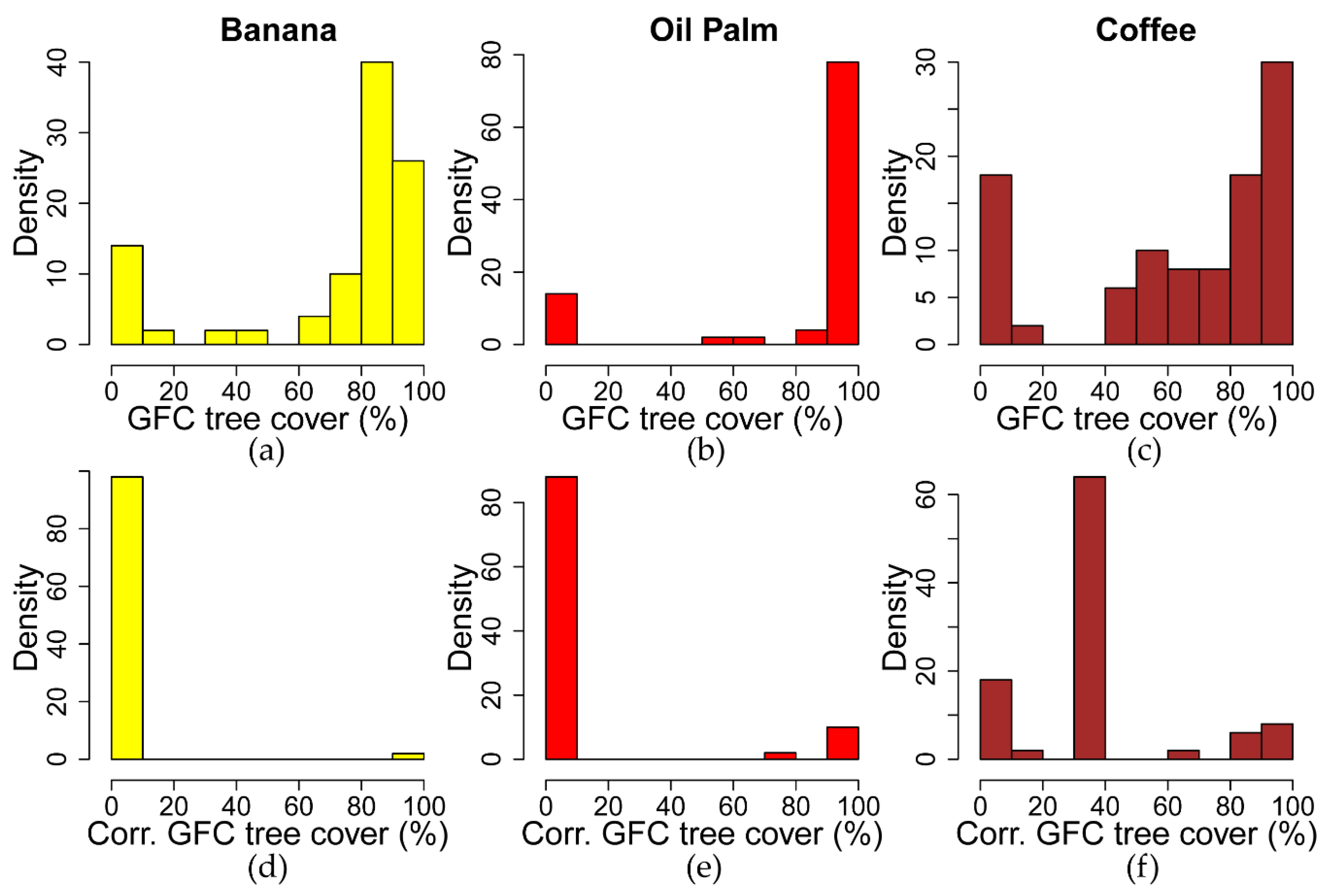



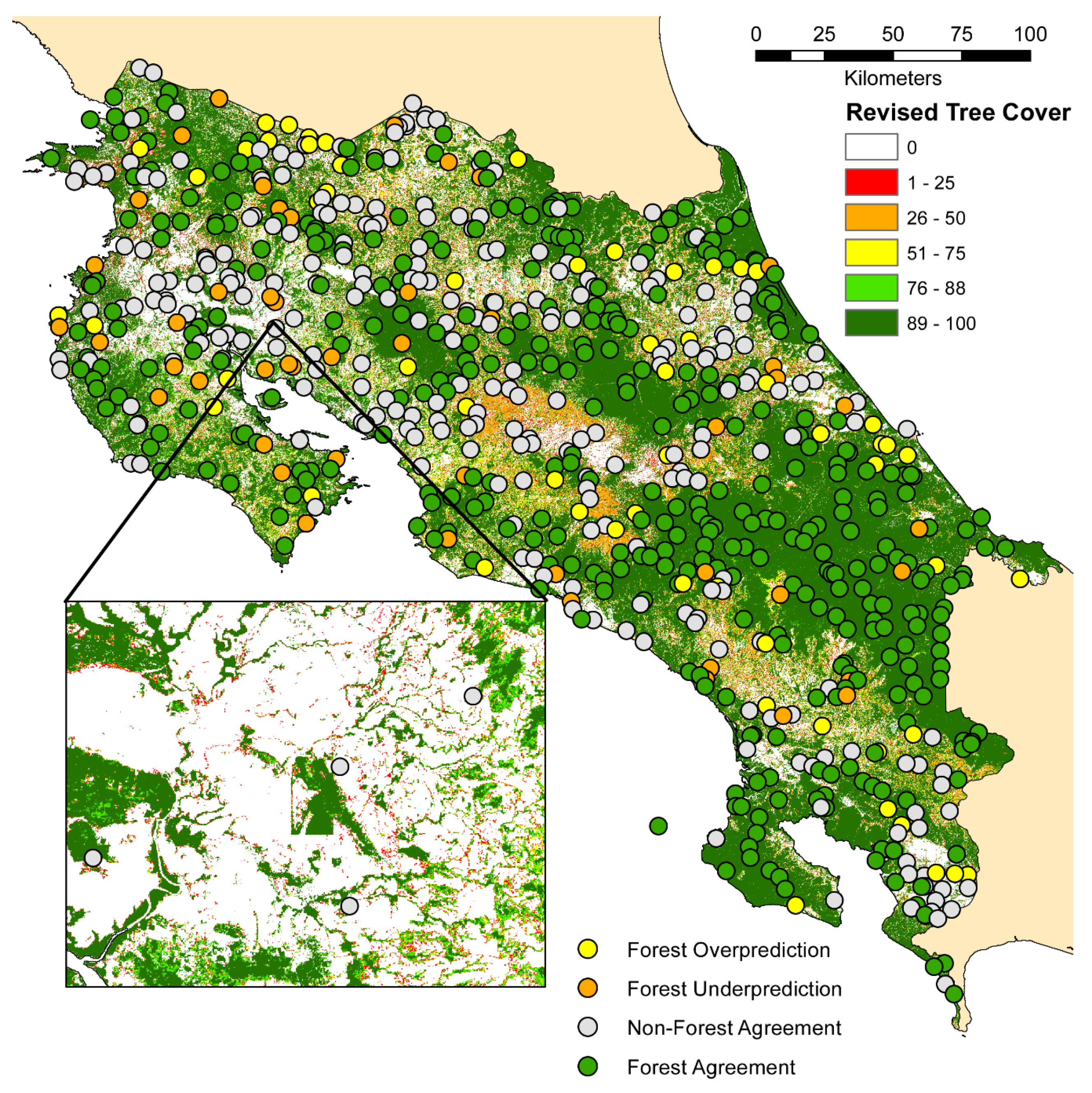
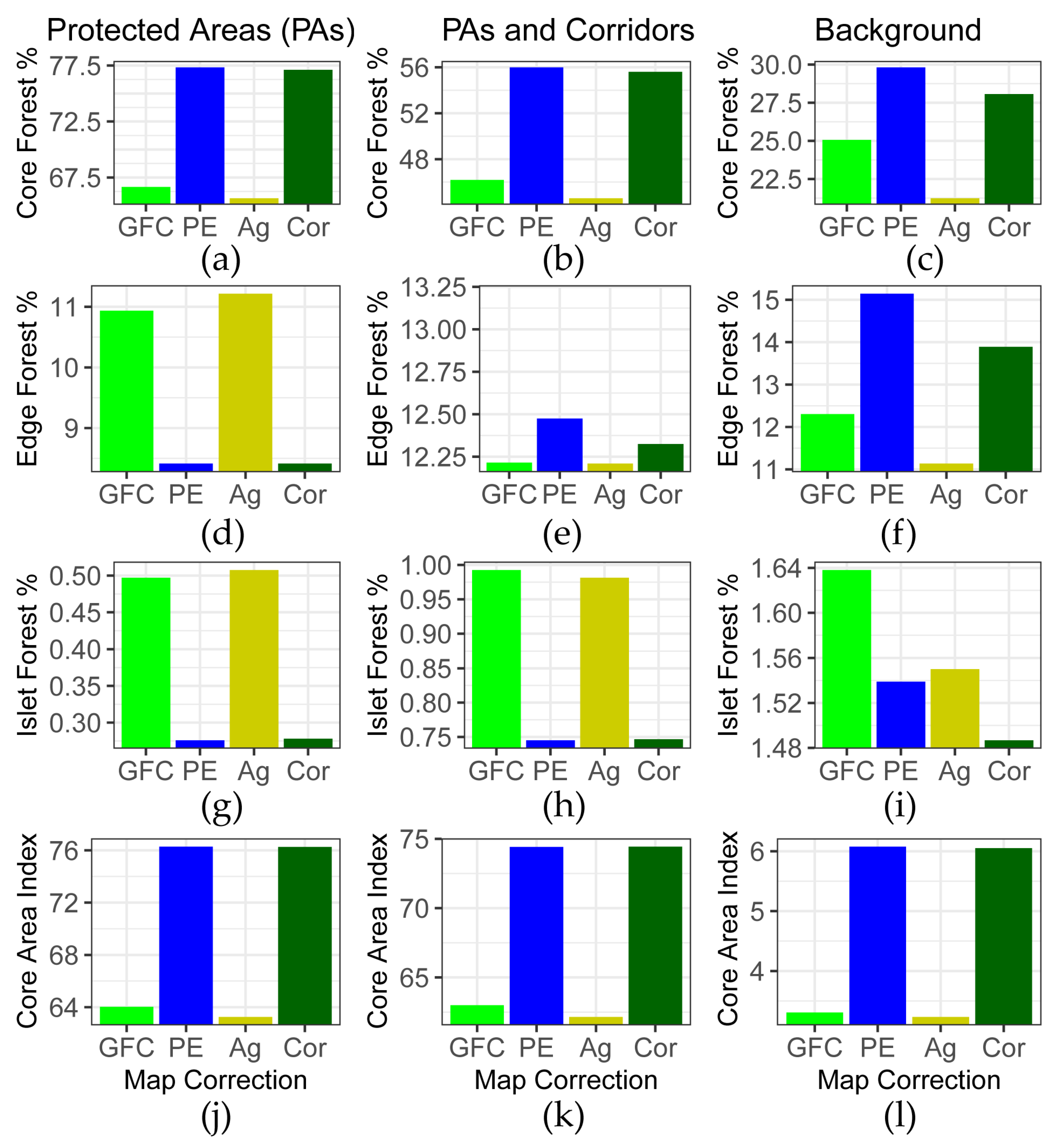


| Raster Input Layer | Year | Source and Spatial Resolution |
|---|---|---|
| Landsat cloud free image composite | 2015 | GFC satellite imagery |
| Band 3 (red) | 30 × 30 m | |
| Band 4 (NIR) | ||
| Band 5 (SWIR) | ||
| Band 7 (SWIR) | ||
| Computed spectral indices | Calculated | |
| NDVI, NBR, LSWI | ||
| GFC tree canopy cover | 2000 | Global Forest Change data |
| GFC loss | 2000–2015 | 30 × 30 m |
| GFC gain | 2000–2012 | |
| GFC loss year | 2000–2015 | |
| Digital Elevation Model (DEM) Slope (DEM-derived) | 2000 | Shuttle Radar Topography Mission (STRM 30 m) |
| ALOS PALSAR | 2015 | JAXA, global mosaic |
| HH, HV, HH/HV | (25 m, resampled to 30 m) | |
| Texture (standard deviation, 3 × 3 moving window) | Calculated | |
| Landsat Band 3, band 4, band 5, band 7, NDVI, NBR, LSWI. | 2015 | |
| ALOS PALSAR HH, HV, HH/HV |
| Model Type | Model Fit (RSMD) | Elevation Trend | Precipitation Trend |
|---|---|---|---|
| OLS reg. | 4105.3 | Negative/Flat | Negative |
| Quant. reg. | 3449.4 | Positive | Negative |
| CART | 2919.0 | Flat | Flat |
| GAM | 2996.5 | Positive | Negative |
| Agricultural Land Cover Map Accuracy | |||||||||
|---|---|---|---|---|---|---|---|---|---|
| Reference | |||||||||
| Classified | Bg | Ri | Sc | Pa | Ba | Op | Co | Total | Users |
| Background (Bg) | 0.9080 | 0.0041 | 0.0000 | 0.0014 | 0.0041 | 0.0041 | 0.922 | 99% | |
| Rice (Ri) | 0.0086 | 0.0180 | 0.0003 | 0.027 | 67% | ||||
| Sugarcane (Sc) | 0.0010 | 0.0025 | 0.003 | 72% | |||||
| Pineapple (Pa) | 0.0007 | 0.0001 | 0.0085 | 0.009 | 91% | ||||
| Banana (Ba) | 0.0007 | 0.0001 | 0.0095 | 0.010 | 92% | ||||
| Oil palm (Op) | 0.0010 | 0.0001 | 0.0083 | 0.009 | 88% | ||||
| Coffee (Co) | 0.0036 | 0.0154 | 0.019 | 81% | |||||
| Total | 0.9237 | 0.0181 | 0.0067 | 0.0085 | 0.0109 | 0.0127 | 0.0195 | 1 | |
| Producers | 98% | 99% | 37% | 100% | 87% | 66% | 79% | ||
| Overall Accuracy | 97.0% ± 0.9 | ||||||||
| Class | Original Map Area (km2) | Corrected Area (km2) | |||||||
| Background (Bg) | 55,979 | 56,101 ± 544 | |||||||
| Rice (Ri) | 1635 | 1101 ± 152 | |||||||
| Sugarcane (Sc) | 207 | 404 ± 282 | |||||||
| Pineapple (Pa) | 565 | 514 ± 32 | |||||||
| Banana (Ba) | 625 | 663 ± 167 | |||||||
| Oil palm (Op) | 573 | 770 ± 286 | |||||||
| Coffee (Co) | 1155 | 1185 ± 295 | |||||||
| Crop Type | Reference | GFC | Revised GFC |
|---|---|---|---|
| Banana | 0% | 86% | 2% |
| Oil palm | 0% | 86% | 12% |
| Pineapple | 0% | 48% | 16% |
| Rice | 0% | 26% | 4% |
| Sugarcane | 0% | 58% | 24% |
| Coffee | 78% | 82% | 82% |
| Total (n = 300) | 13% | 64% | 23% |
| Reference Data Thresholded at 89% | |||||
|---|---|---|---|---|---|
| GFC, Original (2015) | Reference Data | ||||
| Predicted | Nonforest | Forest | Total | User Acc. | Original Map Area (km2) |
| Nonforest | 0.3623 | 0.1245 | 0.487 | 74.4% | 29,571 |
| Forest | 0.0788 | 0.4343 | 0.513 | 84.6% | 31,167 |
| Total | 0.4412 | 0.5588 | 1 | Overall Acc. | Corrected Area (km2) |
| Prod. Acc. | 82.1% | 77.7% | 79.7% ±2.9 | NF: 26,797 ± 1763 For: 33,941 ± 1763 | |
| Revised GFC | Reference Data | ||||
| Predicted | Nonforest | Forest | Total | User Acc. | Original Map Area (km2) |
| Nonforest | 0.3563 | 0.0702 | 0.426 | 83.5 | 25,901 |
| Forest | 0.0802 | 0.4934 | 0.574 | 86.0 | 34,838 |
| Total | 0.4365 | 0.5635 | 1 | Overall Acc. | Corrected Area (km2) |
| Prod. Acc. | 81.6 | 87.6 | 85.0 ±2.6 | NF: 26,510 ± 1574 For: 34,228 ± 1574 | |
© 2020 by the authors. Licensee MDPI, Basel, Switzerland. This article is an open access article distributed under the terms and conditions of the Creative Commons Attribution (CC BY) license (http://creativecommons.org/licenses/by/4.0/).
Share and Cite
Cunningham, D.; Cunningham, P.; Fagan, M.E. Evaluating Forest Cover and Fragmentation in Costa Rica with a Corrected Global Tree Cover Map. Remote Sens. 2020, 12, 3226. https://doi.org/10.3390/rs12193226
Cunningham D, Cunningham P, Fagan ME. Evaluating Forest Cover and Fragmentation in Costa Rica with a Corrected Global Tree Cover Map. Remote Sensing. 2020; 12(19):3226. https://doi.org/10.3390/rs12193226
Chicago/Turabian StyleCunningham, Daniel, Paul Cunningham, and Matthew E. Fagan. 2020. "Evaluating Forest Cover and Fragmentation in Costa Rica with a Corrected Global Tree Cover Map" Remote Sensing 12, no. 19: 3226. https://doi.org/10.3390/rs12193226
APA StyleCunningham, D., Cunningham, P., & Fagan, M. E. (2020). Evaluating Forest Cover and Fragmentation in Costa Rica with a Corrected Global Tree Cover Map. Remote Sensing, 12(19), 3226. https://doi.org/10.3390/rs12193226




